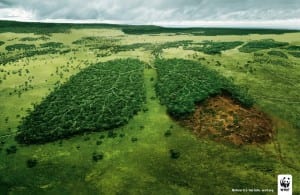Most people view cigarettes as a health problem, but they are a huge environmental problem as well. The entire life cycle of a cigarette has an impact on the environment – from growing the tobacco to throwing away the butt.
Tobacco Farming
Tobacco cultivation is responsible for a myriad of environmental problems, including land and water pollution due to pesticides as well as deforestation. Tobacco plants are prone to many insect pests, and therefore tobacco farmers are forced to use pesticides to keep the plants healthy. Not only do tobacco growers often get sick from the pesticides, but the pesticides also leach into the soil and water.

Tobacco growth and cultivation also causes deforestation. Trees are often cut down to make room for tobacco plants. Once tobacco plants have been harvested, they are “cured.” Sometimes the curing is done by air drying, but often tobacco is cured by burning wood to heat the air, which speeds up the process.
It’s estimated that 600 million trees are cut down every year to produce tobacco products and cigarette-manufacturing machines use up to four miles of paper an hour to roll and package cigarettes.
To read more about tobacco farming click here>
Air Pollution
As mentioned above, tobacco cultivation is a source of air pollution. But cigarettes also have a significant effect on air pollution while they are being smoked. When cigarettes are burned, they create more than 7,000 chemicals. At least 69 of these chemicals are known to cause cancer, and many are poisonous.
A study in Italy found that cigarettes release 10 times as much particulate matter into the air as a diesel engine. Smoke from cigarettes and from tobacco cultivation is contributing to climate change.
It’s well established that second hand smoke is extremely dangerous. It should be considered an environmental problem as well as a public health concern.
To read more about tobacco and air pollution click here> or here>
Butts
In 2009, tobacco products—primarily cigarette butts— comprised nearly 38% of all collected litter items from roadways and streets. In 2010, over one million (1,181,589) cigarettes or cigarette filters—enough to fill 94,626 packs—were removed from American beaches and inland waterways. Cigarette butts are toxic to animals and children that may swallow them, they pollute groundwater, and they leach chemicals into soil. Compounding this problem is the waste from other items related to smoking such as cigarette packages and lighters or matches. Cigarette butts and other tobacco-related trash are a massive environmental problem.
To read more about cigarette butts, click here> or here>
What can you do?
Quit Smoking
– not only is it good for your health, it’s good for the environment!
Become an Advocate
– Communities across the United States are beginning to take action against tobacco waste. Contact your local, state, or federal officials and voice your opinion on tobacco waste!
Utilize your Network
– help educate your network and the public about the environmental harms of tobacco by sharing this and other information, especially on Twitter or Facebook using this sample message:
This #EarthDay, learn how unforeseen consequences of tobacco can cause so much harm: ash.org/earthday2015 #StandWithHealth @ASHOrg








